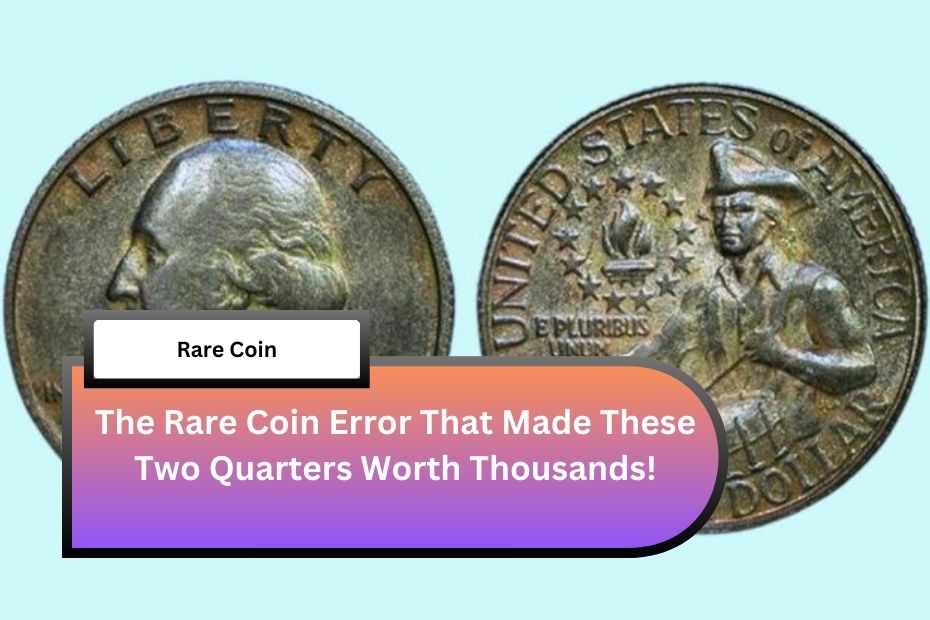Rare Coin with minting errors often attract a lot of attention from collectors, especially when these mistakes make them more valuable than regular coins. Many people don’t realize that a simple mistake during production can turn an ordinary coin into a treasure worth thousands of dollars. In this article, we’ll explore two famous examples of such coins—the 1932-D Washington Quarter and the 2004 Wisconsin State Quarter. These coins are not just valuable because of their history or design, but because of the minting errors that make them so unique and sought after by collectors.
1932-D Washington Quarter: A Rare Treasure
The 1932-D Washington Quarter is one of the first quarters in the Washington quarter series, making it special on its own. However, what truly makes this coin stand out is a minting error called the “double die obverse” (DDO). This error happens when the design on the coin gets stamped twice, causing the letters and images to appear doubled. It creates a noticeable visual effect that makes this quarter unique.
What makes this coin even rarer is its low production number. Only 436,800 of these quarters were made, which is very few compared to other years. Because of this low mintage and the double die obverse error, the 1932-D Washington Quarter is highly valuable. Depending on its condition, this coin can be worth anywhere between $10,000 to $50,000 at auction. The more perfect the condition of the coin, the higher its value can be.
Collectors love this coin because it combines both historical importance and a very special mistake that sets it apart. So, if you have a 1932-D Washington Quarter, it could be worth a lot more than you think!
2004 Wisconsin State Quarter: The Extra Leaf Error
Another famous minting mistake that caused a quarter to become valuable is the 2004 Wisconsin State Quarter. This quarter was part of the 50 State Quarters series, which featured different designs for each state. The Wisconsin quarter has an image of an ear of corn on the reverse side, but an error during the minting process caused an extra leaf to appear on the corn.
This error is called the “extra leaf” error. There are two versions of this mistake—one with a high leaf and one with a low leaf. The extra leaf was a result of a mistake made when the dies (the tools used to stamp the designs on coins) were adjusted. The mistake made the coin look different from the intended design, and this difference is what makes it so valuable today.
The Wisconsin Extra Leaf Error quarters can be worth between $1,000 and $10,000, depending on which version of the error they have and their condition. Just like the 1932-D Washington Quarter, the rarity and uniqueness of this coin make it a must-have for serious collectors. Many collectors go after these coins because of their unusual design and the story behind the mistake.
Why Minting Errors Matter to Coin Collectors
Minting errors might seem like small mistakes, but they can make a big difference in a coin’s value. These errors make certain coins stand out from the thousands of other coins in circulation. For coin collectors, finding a coin with a minting error is like finding a hidden treasure. It’s rare, exciting, and can lead to a significant increase in the coin’s worth.
When a coin has an error, it can become a piece of history. Collectors look for these special coins because they tell a story. The story behind a minting error can make the coin even more valuable, as it adds a layer of mystery and interest. The 1932-D Washington Quarter and the 2004 Wisconsin State Quarter are perfect examples of how a mistake during the minting process can turn an ordinary coin into a prized possession.
The Importance of Coin Hunting
For those who are interested in coin collecting, it’s important to always inspect your coins carefully. Coins that might look ordinary at first glance could have rare errors that make them valuable. It’s also essential to know what to look for when searching for coins with minting mistakes. Understanding the different types of errors and how they affect the value of coins is crucial for any collector.
Coins like the 1932-D Washington Quarter and the 2004 Wisconsin State Quarter are rare, but they are not the only valuable coins out there. Minting errors happen more often than you might think, so it’s always worth checking your change or searching through coin collections. You never know when you might find the next valuable coin!
Conclusion:
In conclusion, minting errors have the power to transform ordinary coins into valuable treasures that collectors are eager to own. The 1932-D Washington Quarter with its double die obverse error and the 2004 Wisconsin State Quarter with the extra leaf are prime examples of how a small mistake can lead to huge value. If you’re a coin enthusiast or someone just starting to collect, always take a closer look at your quarters—you might find a rare treasure that could be worth thousands of dollars. Keep in mind that every coin has its own story, and sometimes the most valuable coins are the ones that stand out because of their unique mistakes.
FAQs
What is a minting error on a coin?
A minting error occurs when a coin is produced with a mistake in its design or features.
Why are minting errors valuable?
Minting errors are rare and unique, making them highly desirable to collectors.
How much is a 1932-D Washington Quarter worth?
It can be worth between $10,000 and $50,000, depending on its condition and the error.

